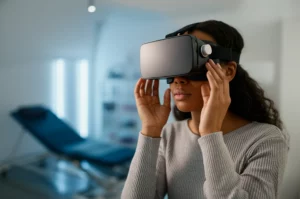Beating the Post-Stroke Blues: How an Ancient Remedy and Exercise Might Help Your Brain Bounce Back
Hey there! Let’s chat about something pretty serious that happens after a stroke: depression. It’s not just feeling a bit down; post-stroke depression, or PSD, is a really common and tough complication that affects nearly half of stroke survivors. It messes with recovery, emotional well-being, and honestly, just makes life harder. Scientists are constantly looking for better ways to tackle this, because current medications, while helpful, can have some unwanted side effects.
So, what if we could find some natural helpers? That’s where this cool study comes in. They looked at two interesting approaches: Ninjin’yoeito (NYT), a traditional Japanese herbal medicine, and good old physical exercise. Both have shown promise individually for mood and brain health, but what happens when you put them together, especially after a stroke? That’s the big question this research aimed to answer, diving deep into what’s happening in the brain and body.
Why Post-Stroke Depression is Such a Headache (Literally)
Think of your brain like a super complex city. A stroke is like a major disruption – roads get blocked, power lines go down. This damage doesn’t just affect movement or speech; it can seriously mess with your mood and mental state. PSD is linked to a bunch of complicated stuff happening inside, like:
- Your stress system going haywire: This is called the HPA axis, and it can get overactive after a stroke, pumping out too much stress hormones like cortisol (or corticosterone in rats).
- Brain growth factors dropping: There’s a key protein called BDNF (Brain-Derived Neurotrophic Factor) that’s like fertilizer for your brain cells, helping them grow and connect. Low BDNF is often seen in depression.
- Brain inflammation: Your brain’s immune cells (microglia and astrocytes) can get overly active after injury, causing inflammation that can harm neurons.
Current treatments often target these areas, but finding effective options with fewer side effects is key. That’s why exploring things like traditional medicines and lifestyle changes is so exciting!
The Study Setup: Putting NYT and Exercise to the Test
Okay, so how did they figure this out? Researchers used a rat model designed to mimic PSD. They gave some rats a small brain injury and exposed them to mild, unpredictable stress – sounds rough, I know, but it helps create a model of depression. Then, they divided the rats into groups:
- A control group (no stroke, no treatment).
- A PSD group (stroke + stress, no treatment).
- A PSD + NYT group (stroke + stress + NYT in their food).
- A PSD + Exercise group (stroke + stress + treadmill exercise).
- A PSD + NYT + Exercise group (stroke + stress + both NYT and exercise).
They gave the NYT in the diet and started the treadmill exercise a few days after the stroke, continuing for four weeks. After this period, they checked a bunch of things: stress hormone levels in the blood, how the rats behaved (though the behavioral tests in this specific model weren’t super clear-cut, which is a limitation they mention), and crucially, what was happening in a part of the brain called the hippocampus – a key area for mood and memory. They looked at BDNF, its precursor proBDNF (which can have opposite effects!), new neuron growth (neurogenesis), and signs of inflammation.

What They Found: Less Stress, Happier Brains?
So, what did the results tell us? Let’s break it down:
Stress Hormones (Corticosterone)
The rats in the PSD group had higher levels of stress hormones in their blood, which makes sense given the stress model. But guess what? The groups that received treatment, especially the NYT-only group, showed *lower* corticosterone levels compared to the untreated PSD group. This suggests NYT might help calm down that overactive stress response system.
Brain Health: BDNF, ProBDNF, and New Neurons
This is where things get really interesting, especially for the combined therapy group.
- BDNF: Exercise alone seemed to boost BDNF in one specific area of the hippocampus (CA1). While NYT and the combination also showed trends of increased BDNF, the exercise effect was statistically significant here.
- ProBDNF: The untreated PSD group had higher levels of proBDNF, which is the “bad guy” version that can actually harm neurons. The combined NYT + Exercise group significantly reduced proBDNF levels.
- The BDNF/proBDNF Ratio: This ratio is thought to be super important for brain health and plasticity. The PSD group had a lower ratio. The NYT + Exercise group showed a *significantly higher* BDNF/proBDNF ratio than *all* other groups. This suggests the combination is really good at tipping the scales towards brain repair and growth.
- Neurogenesis (New Neurons): Markers for new neuron growth were significantly higher in the NYT + Exercise group compared to the NYT-only and untreated PSD groups. It seems the power duo is better at encouraging the birth of new brain cells.
- Existing Neurons (NeuN): The PSD and NYT-only groups had fewer mature neurons compared to controls. Both the Exercise and the NYT + Exercise groups showed significantly higher levels of mature neurons compared to the PSD group, suggesting these interventions might help preserve existing brain cells.
Brain Inflammation
Remember those overactive brain immune cells? The study found that in the PSD group, these cells (microglia and astrocytes) were indeed more activated in the hippocampus. But in *all* the treatment groups (NYT, Exercise, and NYT + Exercise), this activation was significantly reduced. They also looked at a specific inflammatory marker, TNF-α, which was increased in the PSD group but lower in all the treatment groups. This is a big deal, as reducing brain inflammation is thought to be key in treating depression.

Putting It All Together: A Powerful Partnership?
So, what’s the takeaway? This study suggests that NYT can help by lowering stress hormones and reducing brain inflammation. Exercise seems to boost BDNF and also reduce inflammation. But the real magic appears to happen when you combine them! The NYT + Exercise group showed the most impressive results in improving the BDNF/proBDNF balance, boosting new neuron growth, and significantly taming brain inflammation in the hippocampus.
While this specific rat model didn’t show clear-cut changes in *behavioral* signs of depression, the changes they saw at the biological level – the reduced stress hormones, the improved brain factor balance, the increased neurogenesis, and the decreased inflammation – are all strongly linked to depression and recovery. It’s like they saw the building blocks of recovery getting stronger, even if the outward behavior wasn’t fully changed in this particular setup.
The researchers point out that NYT, with its mix of herbs, likely has multiple ways it helps, and exercise adds its own benefits. When combined, they might work together in a synergistic way, meaning their combined effect is greater than the sum of their individual effects.

A Glimpse into the Future?
Of course, this was a study in rats, and we can’t directly translate these findings to humans just yet. More research is definitely needed, perhaps using different models or looking at different aspects of PSD. They also mention that the exercise intensity or frequency might matter, and that future studies should look at potential sex differences (this study used only male rats).
Despite the limitations, the findings are really promising. They give us a clearer picture of *how* NYT and exercise might be helping at a biological level in the brain after a stroke. It reinforces the idea that non-pharmacological approaches can be incredibly valuable, and that combining therapies might be the way to go for complex conditions like PSD.
Imagine a future where stroke recovery plans routinely include tailored exercise programs and perhaps even traditional herbal support like NYT, working together to not only restore physical function but also help the brain heal and bounce back emotionally. That would be pretty amazing, wouldn’t it?
Source: Springer







